Winter in New York City can be brutal, but I think back fondly on those frigid Sunday mornings when I’d brave the cold to join The Council of McSorley’s.
The Council was a ragtag group of spiritually curious creatives probing art and life’s biggest questions over at NYC’s oldest saloon. Even the urinals carried history - legend has it, Abraham Lincoln once used them!
The floor was strewn with sawdust, mugs of ale ran aplenty, and a cheeseboard with terrifyingly spicy mustard often made an appearance. Sometimes, if we’d attended Latin Mass that morning, conversation turned to its labyrinthine history and rituals. With different cultures and beliefs represented, our debates were always lively.
I grew up in a Protestant missionary family overseas. Church was a barebones affair, held in plain auditoriums and gymnasiums. So the first time I poked my head into a Catholic parish church in NYC, it took my breath away. It smelled of incense and looked like Europe. I could feel the accumulation of history. In short, it was a moving sensory experience that resonated with my inner filmmaker.
I came to appreciate how one of my favorite directors, Martin Scorsese, channels the visual and acoustic richness of his faith into his art - but more on that later.
For now, let’s discuss Conclave, a sumptuous thriller directed by Edward Berger (All Quiet on the Western Front), based on Robert Harris’ 2016 novel. The film broke through at the box office and has picked up a lot of steam in awards season. For example, The American Film Institute named it as one of the top titles of 2024. It won Best Screenplay at The Golden Globes and has picked up eight Oscar nominations, including Best Picture, Best Adapted Screenplay, and Best Production Design.
The story follows Cardinal Lawrence, who leads his peers through the secretive process of electing the next Pope. They sequester in a special dormitory, meet in the Sistine Chapel, and communicate with the outside world only through the use of smoke. Gray smoke indicates that no candidate has received enough votes to be selected, while white smoke indicates that a consensus has been reached.
Lawrence navigates a labyrinth of competing interests and scandals. Egos clash, some advocating for more liberal views, others preaching fire and brimstone. It’s a procedural that’s driven from beat to beat mainly by conversation.
As Lawrence, Ralph Fiennes gives an Oscar-worthy performance. His quiet gravitas makes you feel the weight of the responsibility he carries - and how much he doesn’t want it. Lawrence would prefer to resign and join a monastic order, but the late Pope denied his request. As a result, in effect, Lawrence suffers from what I call “The Aragorn Complex”. He’s reluctant to lead because he feels unworthy, which stems from his struggles with doubt, not only of the Church but also of the faith itself.
In kicking off the conclave, Lawrence actually embraces his struggle:
It’s a compelling cry for institutional change… For tearing down the insular walls the Church has built to separate itself from the people. Ironically, this scene sets up Lawrence himself as a contender for Pope, which is the last thing he wants!
Director Edward Berger breaks it down in a brilliant analysis, exploring how different shot types and editing choices work together to shape the scene’s emotional flow:
For most of the film, the Cardinals are cut off from the rest of the world. But Conclave blows a hole in their seclusion both figuratively and literally, as a result of a terrorist attack. My favorite scene comes in the wake of the bombing, as they prepare to vote one last time. Critic Houston Coley describes the moment with conviction:
The windows above the room remain blown open by the blast. As they sit in a contemplative daze, something changes. The air begins to move and stir, reaching deep into their hearts. Rarely have I witnessed such a perfect cinematic distillation of the ancient understanding of the Holy Spirit as “breath” or “wind”… The Cardinals cast their vote… with renewed relationship to God’s good world.
[Spoiler alert] In a twist ending that some have criticized as underdeveloped, Lawrence learns the truth about Cardinal Benitez, whom the conclave unexpectedly elects as Pope. Benitez, a thoughtful and empathetic leader previously working in conflict zones, is intersex. “I am as God made me,” he explains gently:
“And perhaps it is my difference that will make me more useful. I think again of your sermon… I know what it is to exist between the world’s certainties.”
Lawrence chooses not to reveal Benitez’s secret to the conclave, so that Benitez can ascend without resistance or controversy. White smoke goes up, signaling that a selection has been made, while Lawrence rescues a lost turtle that belonged to the late Pope. The turtles in the film function as a strong visual motif. They live on land and water, suggesting the Church’s adaptability under Benitez, who represents change yet who was voted in by tradition - a bridge from the past to the future.
Or as Fiennes puts it, the turtles symbolize “spiritual independence”.
Narratively, then, the film comes full circle. The election ends along with Lawrence’s crisis of faith, resolving plot imperative and character imperative together.
The last scene shows Lawrence alone in his room, praying for the first time in a long time. He looks out the window at three nuns in the courtyard, the film’s final image. It hints that women have more to give to the life of the Church… That under Benitez, women will become more than “invisible” witnesses to roomfuls of politicking men.
Much like Lawrence, Conclave as a whole boasts a lot of heart and thematic depth. A tight script, masterful performances, and lavish cinematography truly elevate it. I mean, just look at these frames! They could be hanging in the Vatican Museums:
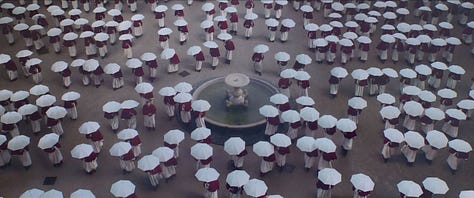
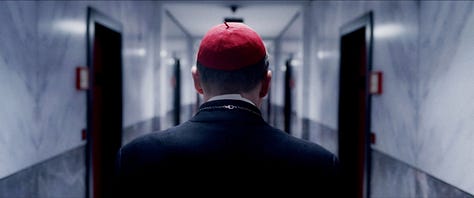
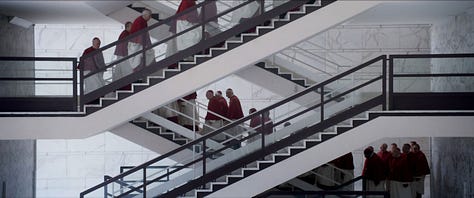
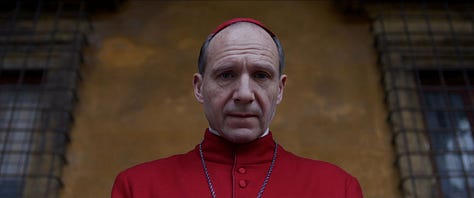
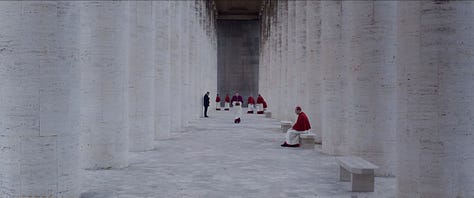

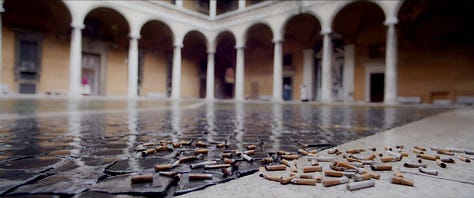
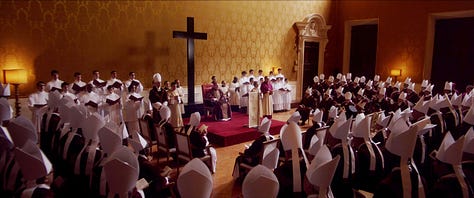
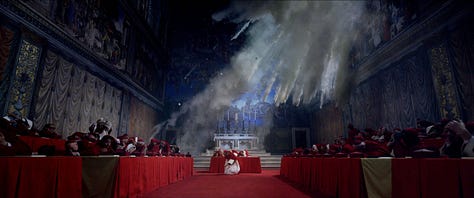
So then why was I left feeling slightly underwhelmed by the experience?
Considering my background, I love stories that wrestle with faith. Why did Conclave leave me with a sense of “meh”, even though I appreciate the craft and message?
My thoughts wandered to Martin Scorsese’s Silence.
Fittingly, I first saw the film in Bali - the only Hindu-majority province in Indonesia - during Nyepi, which literally means the “Day of Silence”.
Nyepi follows the previous day’s Ngrupuk Parade. Statues of demons and other mythological beings called “Ogoh-Ogohs“ are marched through the streets to the cemeteries, where they’re burned to ashes as a symbol of self-purification:


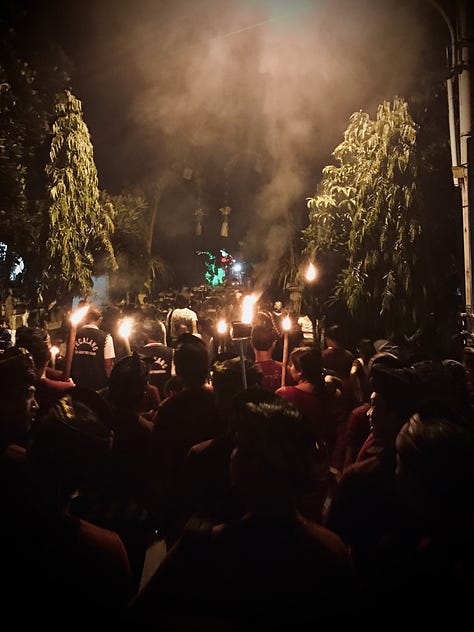
With the evil spirits defeated, Nyepi becomes a day reserved for self-reflection.
You’re not supposed to work, travel, talk, or eat.
The only people outdoors are the pecalang, traditional “security men” who patrol the streets to ensure that the rules are followed. Foreigners can do as they please inside their hotels, but violating the rules in plain sight could lead to deportation.
We honored the spirit of the holiday by watching Scorsese’s spiritual epic.
Like Conclave, Silence adapts a novel. It tells the story of two Jesuit priests who go to Japan in the seventeenth century, where Christianity is strictly forbidden. While attempting to spread the faith, they search for their missing mentor.
They find him - and he forces them to question everything.
Should they commit apostasy in order to spare themselves and their converts from torture and suffering? What’s the right thing to do? What would their God do?
Unlike Conclave, I realized, Silence offers no easy answers. Its painstaking craft - including the cinematography, which was honored with an Oscar nomination - immerses us not in a tightly-wound thriller but in a raw, existential journey.
There is no promise of enlightenment. I’ve seen the film three times, and I still struggle with its deeper meaning, much like Father Sebastião Rodrigues, played by a soulful Andrew Garfield, struggles with his beliefs.
Scorsese’s insights here are helpful. In an interview, he explains that the story depicts a struggle “for the very essence of faith, stripping away everything else around it”:
The vehicle that one takes towards faith can be very helpful. So, the Church - the institution of the Church, the sacraments - this all can be very helpful. But ultimately it has to be yourself, and you have to find it.”
I think of the “spiritual independence” Fiennes sees in Conclave. Clearly, the two films share some thematic DNA, but they’re very different in execution.
Silence is BUILT around the search for faith. While Lawrence’s search in Conclave fuels the narrative engine, in Silence, Rodrigues’ search for faith is the narrative engine. It’s built from the inside out, not the outside in. As a result, Silence embraces a nuanced “form follows function” approach to its story that feels more exploratory than prescriptive. Its construction is informed - uncompromisingly - by its ambition.
“When you talk about why did it take me so long to be able to attempt to put it on the screen,” Scorsese reveals, “That’s the issue: the inside out. It wasn’t the obvious story. It really was deeper… To the very understanding of what compassion is about.”
Also unlike Conclave, Silence was a box office flop.
It’s far heavier, far more complex, and far less formulaic - a big ask of the audience.
Which is precisely why I prefer it. Scorsese’s film is far more to my taste. It reflects my own experience of faith as a living thing, shaped by cross-cultural considerations, wartime conflicts, maverick personalities, failing institutions, and moral ambiguities.
But those are stories for another day.
To be clear, I’m not saying that one film is qualitatively better than the other! Both more or less accomplish what they set out to achieve. Silence is a demanding externalization of the internal experience of faith, whereas Conclave plays more like a traditional thriller with earnest but comparatively modest thematic ambitions. One reviewer described it as a straightforward, “middlebrow” movie “that doesn’t insult or overly challenge our intelligence”, which feels like a fair assessment.
As a screenwriter, I’m not quite sure what to do with the fact that I gravitate toward the more audacious of the two films… Obviously, you want your film to make its money back, if only so that you have the opportunity to make the next one!
So where’s the line?
How do you challenge audiences without alienating them? Do bold, uncompromising films only come with a small budget - or the cachet of an auteur?
Questions for The Council of McSorley’s, to which you’re cordially invited here! What do you think? Did you like Conclave? I’d love to hear your thoughts in the comments!


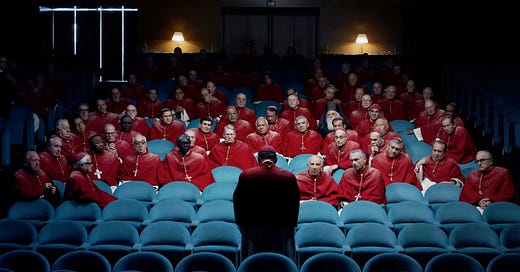







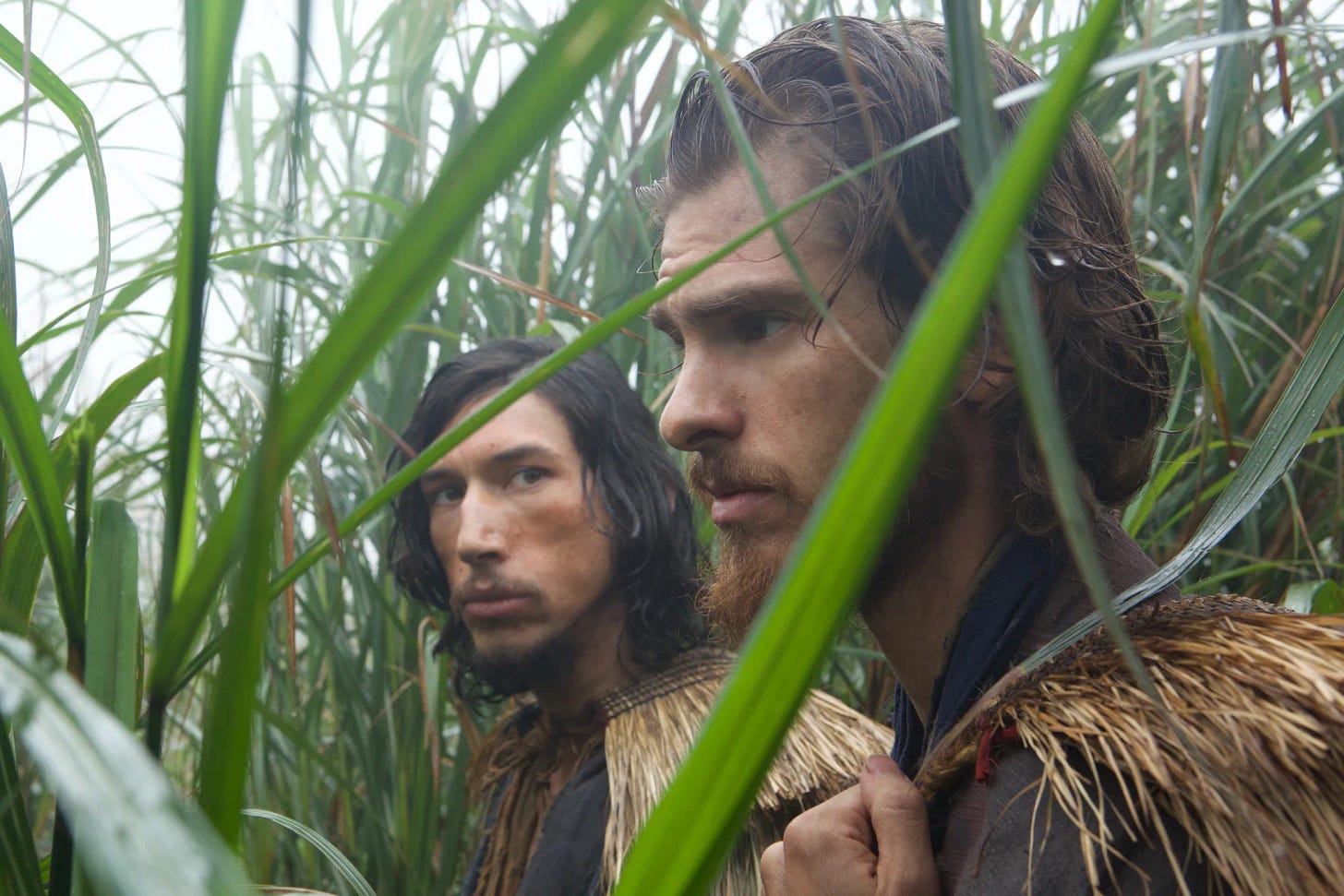





Love this breakdown, Michael. I appreciate how you think so deeply about all angles. I'm sure you put the same care into your screenplays.
-Jeff
I agree with you about being underwhelmed by Conclave. But I have not seen Silence, and it now goes to the top of my watch list.
I also very much appreciate the shout out to McSorley's. I attended the NYU Graduate Film program which was located down the street from the Ale House and spent many afternoons with my fellow film students discussing and analyzing films. Nothing as formal as your council, but your remarks brought back the hops infused atmosphere and the joy of such discussions.